
The silver Persian cat has one of the rarest coat colors in this breed. The other is the golden Persian cat. In this article, we will explain everything we know about how these beautiful, rare cats get their look.
Silver Persian cats are expected to have green or blue-green eyes. Most breeders and cat associations look for cats with darker, deeper-colored eyes. These colors can fade as the silver Persian cat ages. The color of the eyes is one way to know if your Persian cat is Silver.

Some definitions you may find helpful:
Genotype: what a cat is genetically – the blueprint from which a cat is created.
Phenotype: what a cat is like on the outside – the stuff you can see with your eyes and feel with your hands
Melanin – Melanin is a class of insoluble pigments found in all animal life that account for the dark color of skin, hair, fur, scales, feathers, etc.
Eumelanin – Eumelanin is a black or brown melanin pigment responsible for the dark coloring of hair, skin, feathers, etc.
Homozygote – Homozygote is an organism with identical genes concerning any given pair of hereditary characters, therefore breeding true for that character.
Heterozygote – A person, animal, or other organism with a pair of differing alleles, one dominant and one recessive of a particular gene.
Epistatic gene – Epistasis is when one gene is affected by one or more independently inherited genes.
Inhibitor gene – An inhibitor gene is a gene that prevents the expression of another gene.

Silver Persian Cat Colors
There are two different types of Silver Persian cats. One is the shaded Silver, and the other is the chinchilla silver Persian. The difference in these isn’t much; recognizing which is which might take a bit. The Shaded Silver Persian cat has a silver shading over their entire body with white underneath. The Chinchilla silver Persian cat is white with pale silver points, usually tabby markings. Another version of the Silver Persian cat is the Golden. These cats have a gold or brown coloration along with dark shading.
The genetics of these Persians are a bit complicated, and research on them is ongoing. However, that can be explained in simple genetic terms. The inhibitor gene is the difference between Silver Persian cats and Golden Persian cats. This gene turns on the golden color in Golden Persians or shuts it off in the Silver Persian cat.
Some more terms that may be helpful:
Agouti – Marked with an A. This gene makes the tabby a tabby with banded hairs. These bands can be different lengths, making the tabby marking different with each length.
B – This is black pigment in the agouti hairs. The color can also be brown or grey.
D – This letter means dense pigment, many dark bands close together.
I – This is for the Inhibitor gene. In the Silver Persian cat, the inhibitor keeps the golden color from displaying. The inhibitor gene is off in the Golden Persian cat, which allows the gold or brown color to show and is indicated by using ii.
Wb – Wide band indicates thick bands on the agouti hairs.
Black Pigment (B) – Melanin is a microscopic color protein granule deposited in the hair shaft. Due to any modifiers present, they can vary in size and arrangement, making variations in color and pattern.
Melanin comes in two forms: dark, round black/brown color granules (B) (eumelanin) and light, elongated red/yellow color granules (O) (pheomelanin). Although both types of color granules are in the hair shaft, they are at varying levels. A black cat, for instance, has an abundance of eumelanin granules but only trace amounts of pheomelanin.
Dense Pigmentation (D)
The dense pigmentation gene (D) allows for the complete expression of pigment. The recessive expression of this gene (dd) represents dilute (blue) pigmentation, as in Blue Silvers and Blue Goldens.
The agouti gene (A)
The agouti gene (A) determines the hair’s pigment distribution in bands of color. The agouti portion of these hairs are yellow-grey bands in between the black color on the hairs, which gives them a brindled appearance. The brindled appearance is caused by a yellow band on the otherwise dark hair shaft. The color of the (A) agouti band can be a darker yellow or orange due to the effect of the polygenetic rufousing (red) factor, which is not a single gene but numerous genes that can intensify or lighten red tones.
The images below show you the agouti bands. You can see how the wide band works, as well as thinner bands on these hairs. On a silver Persian, the yellowish agouti color is inhibited or turned off, so you don’t get the yellow color. These images are complimentary of my domestic shorthair tabby, Thumbs.


In black-based colors, the agouti band marks the period where melanin production has slowed. The granules in the hair shaft have been fragmented, which gives them a yellow-to-orange color as they reflect light in various shades of brown. The yellow band is absent in the non-agouti solid black cat, so the hair shaft has a dark pigment only.
The Inhibitor Gene (I)
The inhibitor gene inhibits the placement of color granules along the hair shaft. In this case, the color will only appear at the tip of the hair. That leaves the base of the hair void of color, appearing to be white. The amount of translucence in the hair shaft depends on other genes, such as agouti, wideband, or both, working with the inhibitor gene. Sometimes, a breakthrough of the pheomelanin occurs. That suggests that perhaps while the inhibitor gene is dominant, there is a limit to the amount of pheomelanin it can suppress. A small amount of pheomelanin pigment shows in isolated areas, resulting in an undesirable color break in the otherwise translucent hair shaft called tarnish.
Wide Band (Wb)
Along with the agouti gene, the wide band gene plays a vital role in the color of the Silver and Golden Persian. The wider the band, the less color will be at the end of the hair shaft.

Conclusion
These genes must work together to make these rare Silver Persian cats. Even breeding for this color can only be produced by luck rather than careful breeding. Many variables must be in place before a Silver or Golden Persian is born. Did you know this about these rarest colored Persian cats? Do you have a Silver Persian cat? Are they smoke, shaded, or chinchilla? Do you know the difference? It takes a practiced eye to know for sure. If you want to tell us anything or have questions, leave us a note in the comments.